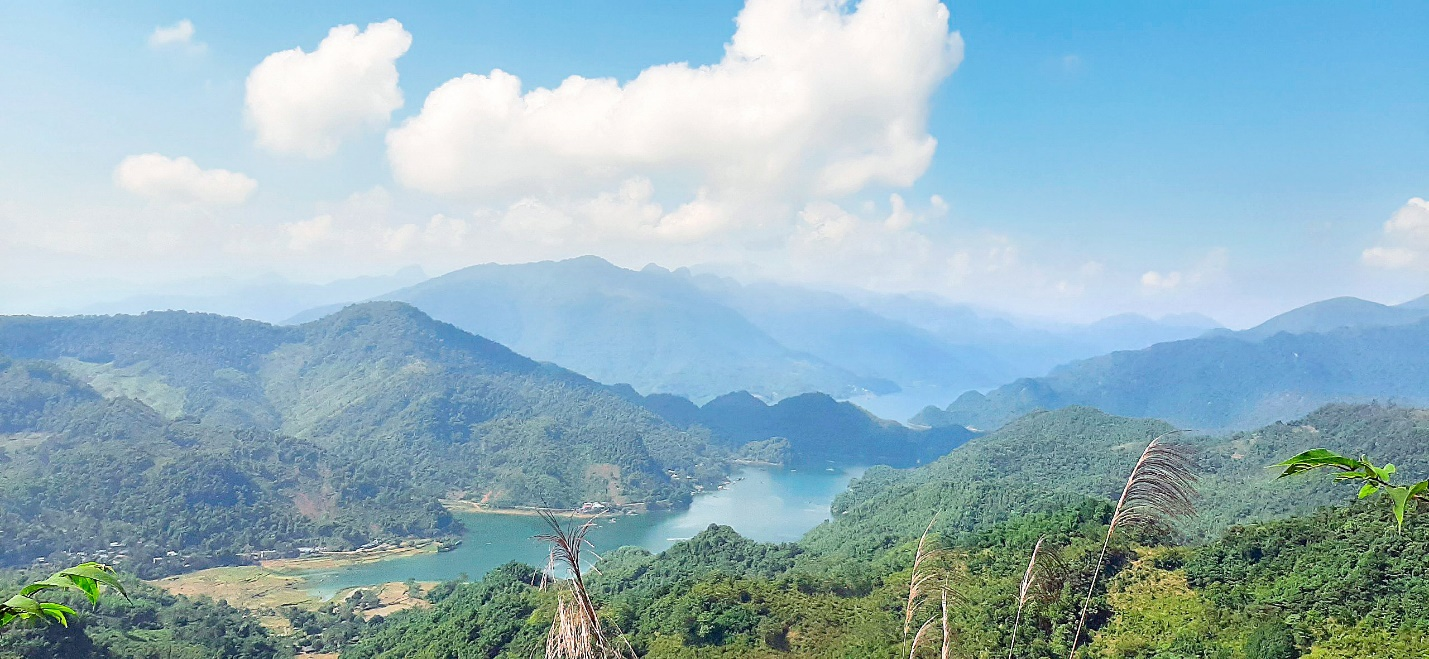
Da Bia - A Tranquil Muong Village Left by the Da Giang River
Da Bia (Đá Bia) Village (Da Bac (Đà Bắc) district - Hoa Binh (Hòa Bình)) is about 120 kilometers from Hanoi and is an ideal destination for those who want to live in a place that has not been "commercialized" by the tourism industry in recent years.
Although there are only 5 households doing community tourism out of 40 in the village, the adjacent homestays in Da Bia village (in Tien Phong commune, Da Bac district, Hoa Binh province) provide all closed services, including houses, meals flavored with mountains and forests, and a cultural program to serve a full teambuilding session, if necessary.
Great renewable energy journey
We arrived in Da Bac in early autumn 2022 at the invitation of a friend and were immediately drawn to this land. The magnificent blue sky, cool air, and especially the drunken yeast warmth of the people here make people love and remember.
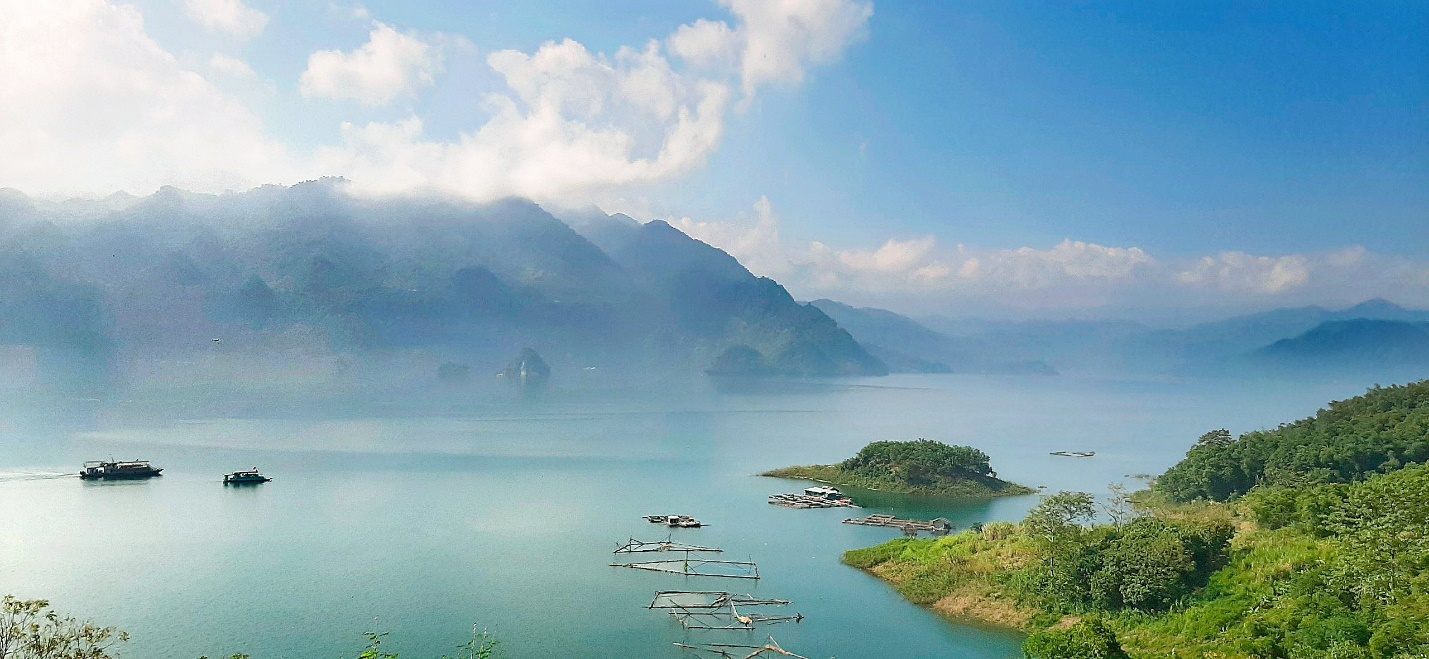 Da Bia's serene beauty
Da Bia's serene beauty
Departing from Hanoi, take the Hoa Lac (Hòa Lạc) highway to Hoa Binh city, descend to the 3-level harbor, experience tourism in the Da (Đà) River's lakebed, and watch the river flow like hair in the clouds of Da Bac. Da River had just had a few days of constant rain when we arrived, but the river water was still a jade-green color. The colors of the sky blended together to create a beautiful chemistry picture. You can visit and perform ceremonies at the Den Ba (Đền Bà) of Thac Bo (Thác Bờ) in Vay Nua (Vầy Nưa) commune of Da Bac district while traveling to Da Bia village.
 The temple of King Le Loi (Lê Lợi) and female general Dinh Thi Van (Đinh Thị Vân) is known as the Ba Chua's (Bà Chúa) Temple. Legend has it that when King Le Loi went to put down the rebellion of Cat Han (Cát Hãn) Pass (an effective henchman of the Minh), she was assisted by Dinh Thi Van - a Muong (Mường) people - while passing through this land. The Le dynasty was able to drive out the Ming and help the people govern thanks to this female general. Thac Ba Temple leans against the cliff, looking out over the vast lake. This is a spiritual tourist destination as well as a place to watch the romantic Da Giang (Đà Giang) river.
The temple of King Le Loi (Lê Lợi) and female general Dinh Thi Van (Đinh Thị Vân) is known as the Ba Chua's (Bà Chúa) Temple. Legend has it that when King Le Loi went to put down the rebellion of Cat Han (Cát Hãn) Pass (an effective henchman of the Minh), she was assisted by Dinh Thi Van - a Muong (Mường) people - while passing through this land. The Le dynasty was able to drive out the Ming and help the people govern thanks to this female general. Thac Ba Temple leans against the cliff, looking out over the vast lake. This is a spiritual tourist destination as well as a place to watch the romantic Da Giang (Đà Giang) river.
Da Bia village, Tien Phong commune, is near the edge of Da River lake and has 40 Muong households. Agriculture remains the people's primary source of income. The project "Community tourism in Da Bac" began in June 2014, with the assistance of the Australian NGO Action on Poverty (AOP) in Vietnam, in collaboration with the People's Committee of Da Bac district.
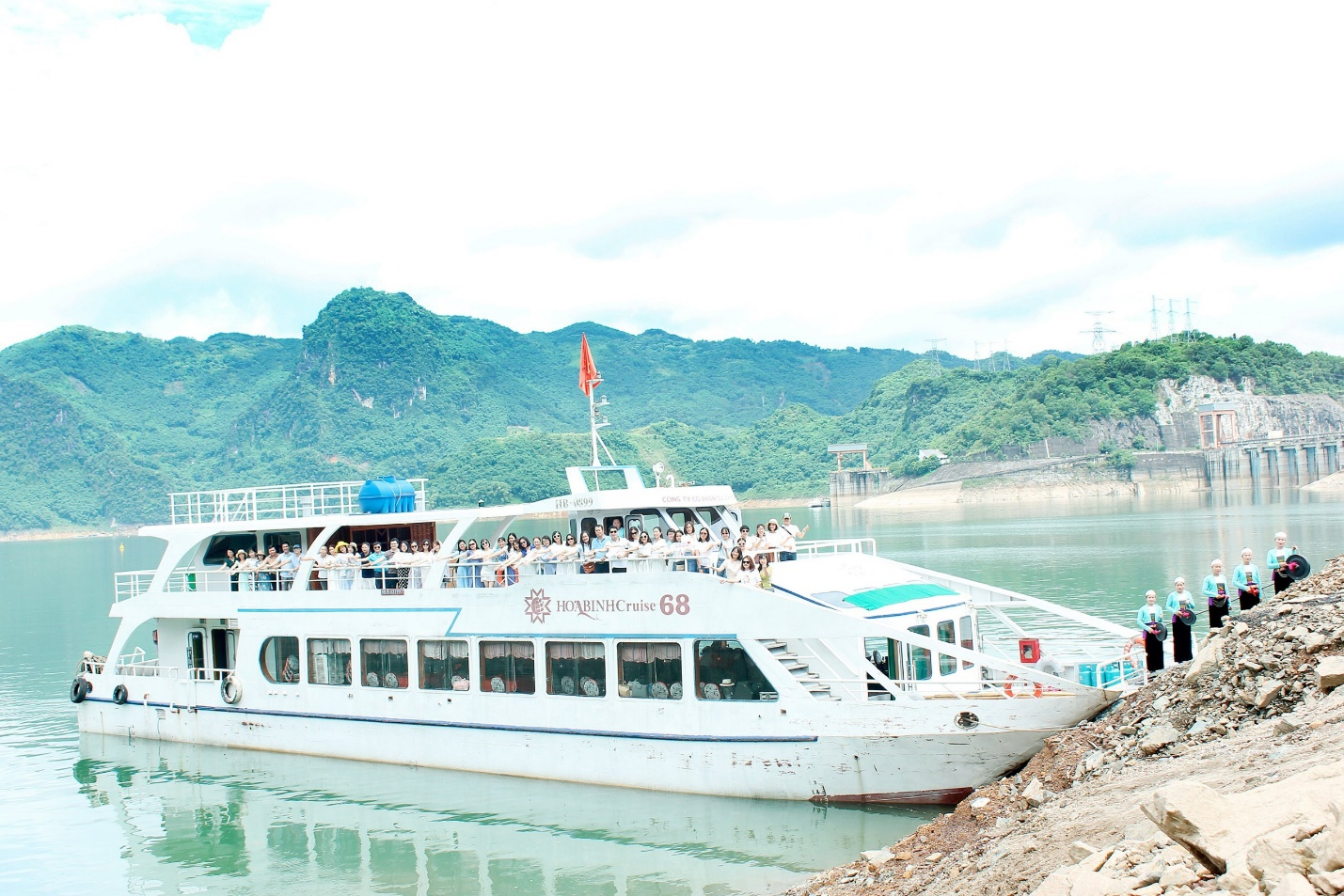 Visitors board a boat and travel to the Da Bia pier.
Visitors board a boat and travel to the Da Bia pier.
Da Bia village currently has 5 community hostels, each with a capacity of 15 to 20 people. To communicate with international tourists, people working as homestay tourists in Da Bia have learned English. The cultural space and landscape are still almost original here, making it ideal for visitors who want to experience and learn about unique cultural values, which are especially appealing to international tourists.
 Ms. Dinh Thi Nhieu (Đinh Thị Nhiệu), the owner of Quang Tho (Quang Thọ) homestay and former captain of the Da Bia Arts team, told us: "Almost every week, international visitors arrive in the village. They usually travel in groups of about ten people, stay overnight, and want to learn about the local people's cultural identity and way of life. Weekend visitors to Bia Bia must usually make a reservation at least two weeks in advance."
Ms. Dinh Thi Nhieu (Đinh Thị Nhiệu), the owner of Quang Tho (Quang Thọ) homestay and former captain of the Da Bia Arts team, told us: "Almost every week, international visitors arrive in the village. They usually travel in groups of about ten people, stay overnight, and want to learn about the local people's cultural identity and way of life. Weekend visitors to Bia Bia must usually make a reservation at least two weeks in advance."

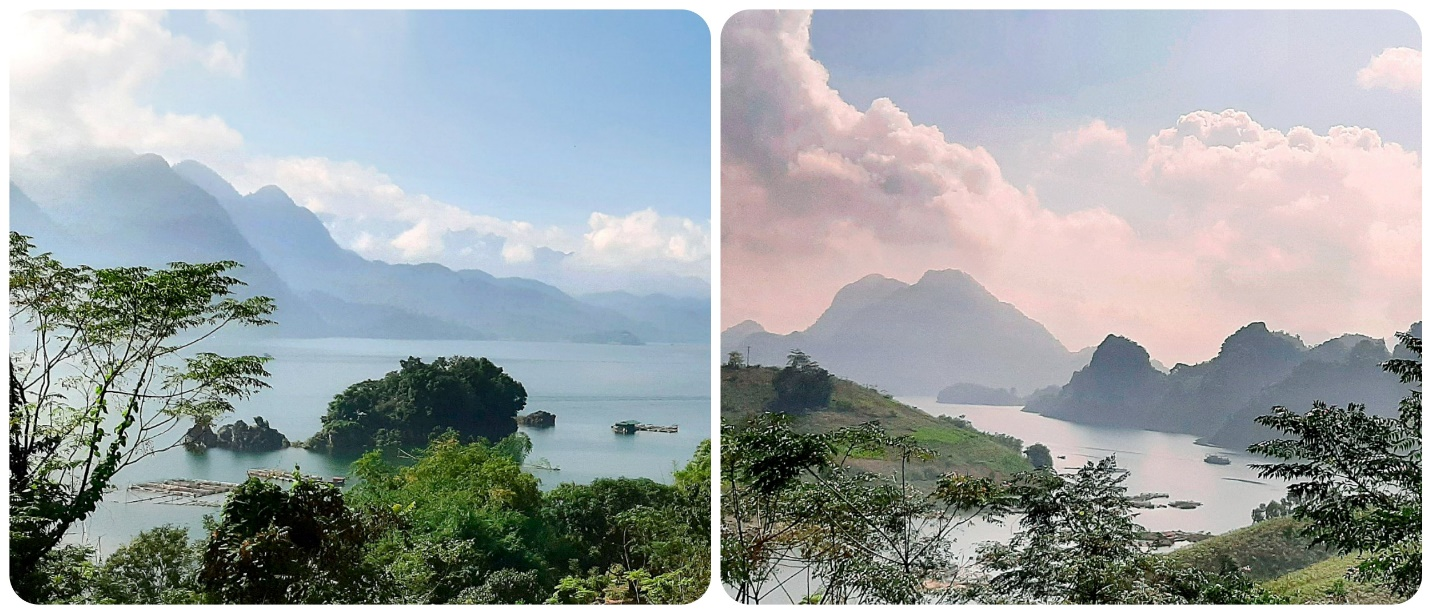 On the Da Giang river, tourists can explore old forests, bays, kayaking, river bathing, swimming, fishing, and shrimp. Guests can participate in the arts, and dance stalls, and drink wine with the village girls in the evening.
On the Da Giang river, tourists can explore old forests, bays, kayaking, river bathing, swimming, fishing, and shrimp. Guests can participate in the arts, and dance stalls, and drink wine with the village girls in the evening.
When dusk falls, the lake bed blends into the forest night and the gong in the soft wine aroma can be heard. The singing invites betel nut against the backdrop of the vivid sounds of flutes, gongs, and gongs blending together, resounding, flying into the deep space. Surprisingly, despite the fact that there are only 5 households, the performances in Da Bia village are extremely rich and meticulously planned. Visitors who simply want to enjoy the songs of the Muong people of the Northwest are served a package according to Ban's program. However, if you need to alternate campfire programs, and team building in groups, the leader of the cultural team in the village also assists the delegation in developing a balanced, harmonic schedule.
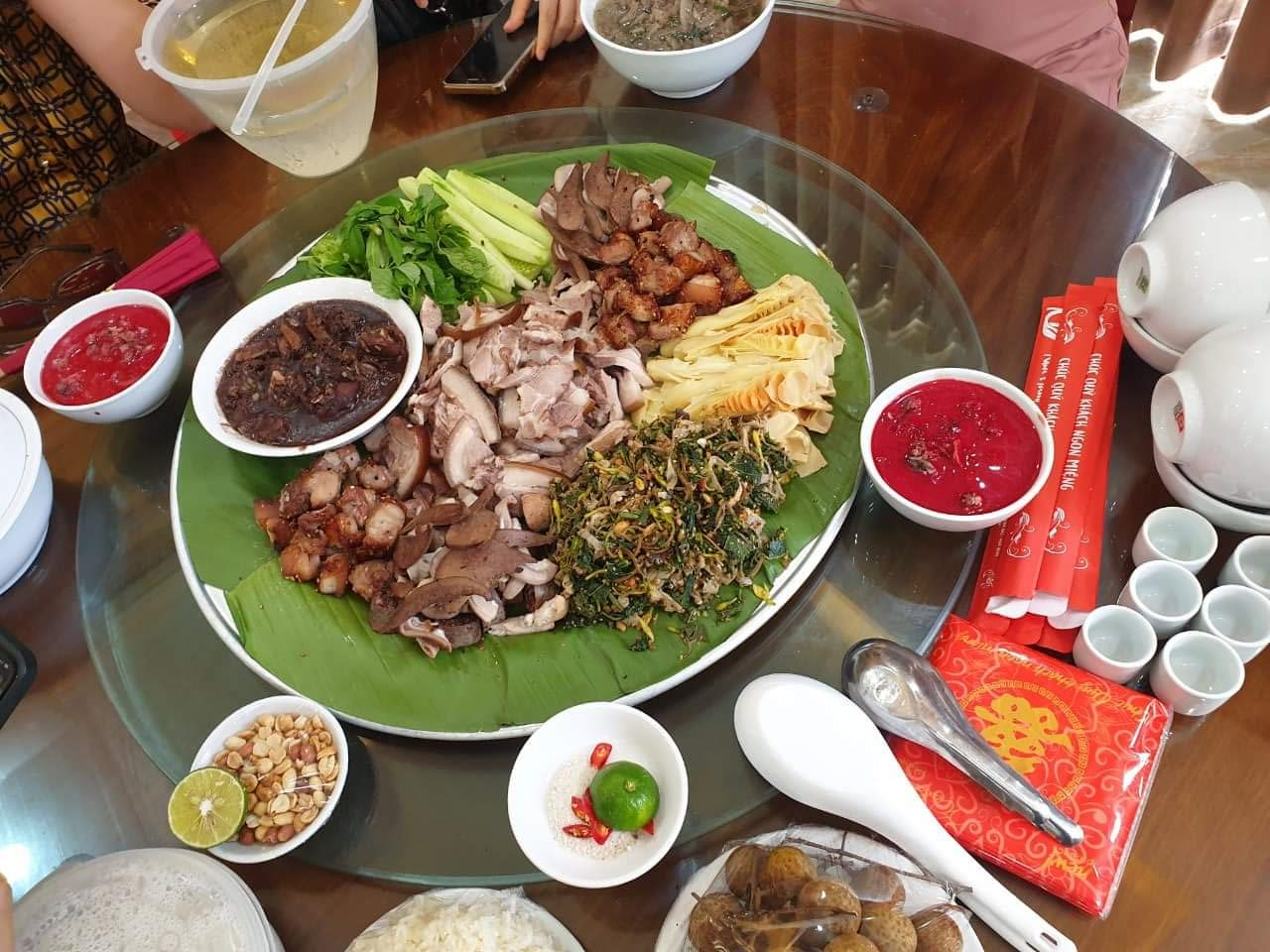 Visitors to Da Bia can enjoy specialties presented on bamboo tips lined with green banana leaves, such as rice wrapped in banana leaves, five-color sticky rice, grilled fish from Da River, dishes made from Muong pig, and especially dishes made from papaya flowers, which people say are unique to Da Bac, such as papaya flowers stir-fried with garlic, papaya flower mannequins, papaya and wild vegetable dishes eaten together with stir-frying fish hearts.
Visitors to Da Bia can enjoy specialties presented on bamboo tips lined with green banana leaves, such as rice wrapped in banana leaves, five-color sticky rice, grilled fish from Da River, dishes made from Muong pig, and especially dishes made from papaya flowers, which people say are unique to Da Bac, such as papaya flowers stir-fried with garlic, papaya flower mannequins, papaya and wild vegetable dishes eaten together with stir-frying fish hearts.
Although it was enjoyable, the peaceful village returned to its original tranquility at 22:00, with the sound of frogs calling at night, oars in the lake, and late cleaners' feet under the stilts. Because the people here follow the new lifestyle model of "turning off the radio speakers at 10 p.m. every night." Simultaneously, small groups of tourists began their love stories. So it appears that every game here has a variety of pitches: lows.
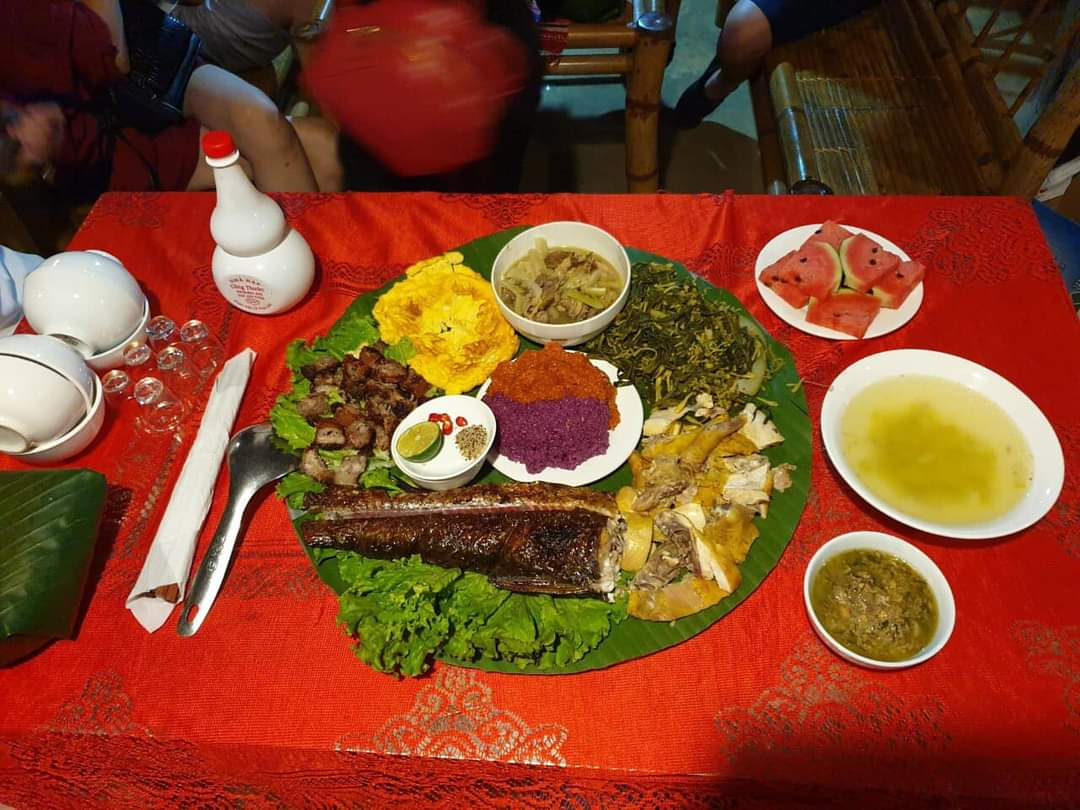 In a warm common story, homestay owner Quang Tho also shows visitors how to eat sticky rice and grilled fish. According to you, guests can order rice to suit their needs, even with European dishes, but almost everyone who comes here wants to sample the local cuisine.
In a warm common story, homestay owner Quang Tho also shows visitors how to eat sticky rice and grilled fish. According to you, guests can order rice to suit their needs, even with European dishes, but almost everyone who comes here wants to sample the local cuisine.
Da Bia transports us back to the early rhythms of life in the midst of city noise, and the most peaceful time is probably early morning. Having slept in an air-conditioned environment, literally in nature's giant air conditioner, the dawn of Da Bia greets the human senses with cool downy dew, and the pristine clean air awakens the senses. The sensation of waking up in a riverside village, and walking along forest paths scented with tangerine flowers, has a lot of renewable energy. We meet the friendly smiles of the indigenous people along the way as an invitation, a certain promise to return to Da Bia.
 The difference between Da Bia and Da Bac (Đá Bạc)
The difference between Da Bia and Da Bac (Đá Bạc)
The model of the "self-conscious shop" is a distinctive feature of Da Bia village that deters visitors. This is regarded as the "first supermarket of Muong Hoa Binh (Mường Hòa Bình) people," demonstrating the Muong Ao Tá people's long-standing culture. There are no sellers in special "supermarkets" that sell agricultural products such as bananas, honey, bamboo shoots, chicken eggs, etc. Visitors select an item from the price list, reset the basket with the corresponding amount, and proceed.
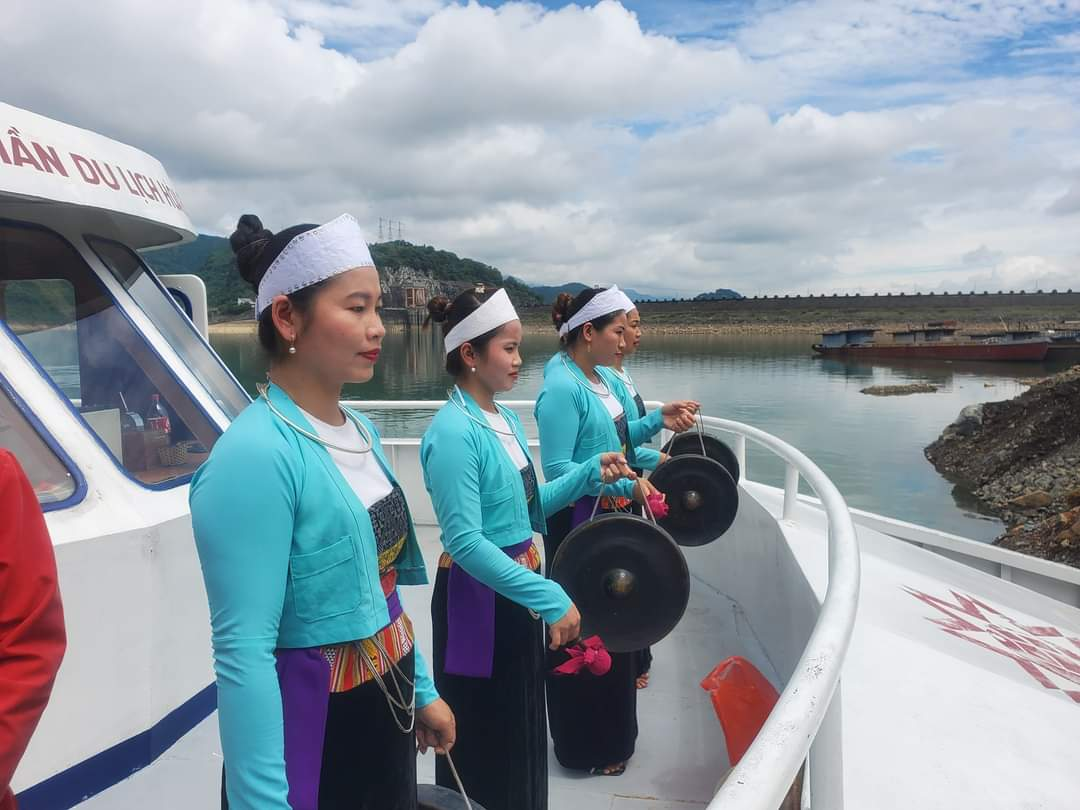 There are two ways to get to Da Bia: a trail along the Da Giang River and a waterway on the Da River's lake bed. Most visitors, however, choose to walk along the lakebed to fully experience the journey to this special oasis. When the ship docked, the men transformed into handrails for the weak-legged, thin-legged girls clinging to the pier. The sensation of climbing the slope slightly backward and admiring yourself for successfully completing the difficult road is strange.
There are two ways to get to Da Bia: a trail along the Da Giang River and a waterway on the Da River's lake bed. Most visitors, however, choose to walk along the lakebed to fully experience the journey to this special oasis. When the ship docked, the men transformed into handrails for the weak-legged, thin-legged girls clinging to the pier. The sensation of climbing the slope slightly backward and admiring yourself for successfully completing the difficult road is strange.
"Why does the government not encourage people to make the road to the village easier?" asked the chairman of Da Bac district, Luong Van Thi (Lường Văn Thi). Mr. Thi stated, "It is not difficult to make things easy, but keeping pristine the land, giving visitors the experience of living as a resident when coming to Da Bia village is truly our desire."
Mr. Luong Van Thi added: "Da Bac's tourism development is still in its infancy, but it is by chance. I value the desire to bring sustainable tourism development models to Da Bac so that it does not repeat the "pain" of rich but overexploited natural areas ". To address this issue, the People's Committee of Da Bac district is on the one hand recruiting investors with resources and vision, and on the other, learning from the experience of many tourism development regions across the country. Mr. Luong Van Thi stated that Da Bac is willing to go slower as long as the land's soul is preserved.
"I cherish the desire to bring sustainable tourism development models to Da Bac so that the 'pain' of rich natural areas that are overexploited does not repeat."
"Keeping your own soul" is probably the most important aspect of the journey to Da Bac. When visitors spend time here, they will undoubtedly form an impression of a very different Muong village. A morning spent sitting on a bamboo grove on a riverside ledge, watching the dark blue Da Giang river will be difficult to forget. It will be difficult to remove the Muong Ao Tá girl's betel nut song from the version: "My hand is made out of betel nut. The mountain shadow reminded me of silent love. The sound of your heart beckoning you. Oath in the midst of heaven and earth, betel nut with eternal meaning "...A second village, similar to Beer Rock, would be difficult to reach. As a result, perhaps when they leave, one expects them to return one day.
Da Bia village has about 40 households, 5 of which are involved in community tourism. Since the construction of the community tourism area, the Muong community's life has changed dramatically. Da Bia community tourism area was awarded the ASEAN Community Tourism Award in 2019.
Source: Hồng Dương - Kim Sen